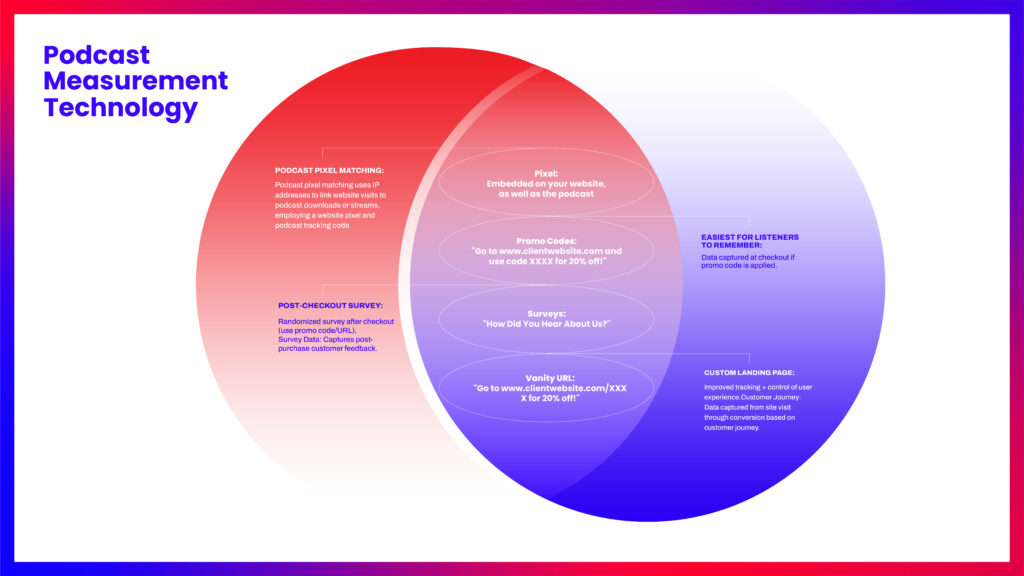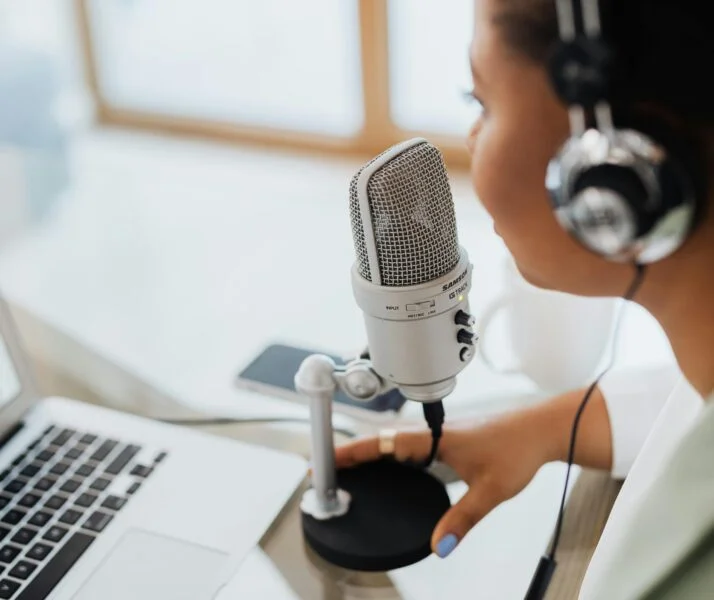
Highlighting the Effectiveness of Podcast Advertisements in 2025
It’s no secret that the audio world is rapidly evolving. As the industry continues to grow, it’s important to know what key trends are shaping the landscape. Below is a deep dive on everything we’re seeing in 2025—and what marketers should be keeping an eye on.
Podcasting has hit an all-time high, with more than 100 million Americans regularly listening. Audiences continue to expand each year and listening time is increasing, too. The average American listened to 8.3 podcast episodes weekly last year according to the latest reports.
Across the globe, podcast audiences are growing. New markets are emerging as podcast listening becomes increasingly popular across Asia and Latin America. Research from Acast indicates that audiences in both emerging and established markets plan to increase the time they spend with the medium this year. Among emerging markets, which include quickly growing areas like Brazil, India, and Singapore, 51% of survey respondents said they would attend a live event from a favorite podcast host and 60% of daily listeners in these areas say they have made a purchase after hearing a podcast ad. These listeners are tuned in to all the latest developments, too—76% have listened to a video podcast, compared to 74% in more established markets like the U.S. and U.K. These developments across the globe indicate that even in emerging markets, podcasting is evolving as quickly as in established markets. Given the engagement of listeners in these emerging markets, brands now have even more opportunities to connect with audiences.
Listening isn’t just growing across geographic borders, it’s also increasing across age groups. In fact, the number of monthly and weekly podcast listeners of every age has increased. While men 25 to 34 years old make up the core podcast audience, Gen Z is set to overtake them by 2027, given that their rate of podcast discovery outpaces every other demographic. Women hit an all-time high of 45% of monthly listeners and 32% of weekly listeners. Listeners aged 55 and older continue to grow at a rapid rate and according to the latest data are the fastest growing segment. Podcasts now reach a considerable 27% of Americans aged 55 and up.
For brands looking to drive consideration, podcasts are quickly proving to be a superior channel. They reach all generations, particularly affluent and educated audiences, which have an average household income exceeding $75,000. But perhaps more importantly, podcast audiences are engaged—and spending. Forty-six percent of podcast listeners have purchased a product or service after hearing an ad on a podcast. “For brands looking to make meaningful connections, they’re seeing value in podcast ads,” said Greg Glenday, Chief Business Officer at Acast. “It’s easy to see why. This medium offers a unique blend of intimacy and reach, letting brands build strong ties with listeners on their own terms.” Video podcasts are also amplifying the power of podcasting. In fact, YouTube became the top platform for podcast listening in the last year and the place where most listeners discover new content. Video podcasts offer all the benefits of traditional podcasts, but with extra engagement from the visual elements. Video offers a new way to diversify podcast placements and activate more brand opportunities, from product placement to short tutorials. Young consumers are a major part of this, as they continue to seek closer relationships with big social media influencers and personalities.
[Read: The Ultimate Guide to Podcast Advertising]
What Is Podcast Advertising and How Does It Work?
In podcast advertising, brands pay for ad space within a podcast show, which can either be pre-recorded or read live by the host. These spots are typically inserted into designated timeslots, such as pre-roll, mid-roll, or post-roll. Podcast ad placements can be bought from ad networks that collect ad inventory from multiple publishers, directly from podcast creators, or programmatically through agencies like ARM who work with demand-side platforms (DSPs) to use audience-based and outcome-based buying approaches.
Types of podcast ads include:
Traditional Ad Units
Ads can be purchased at predetermined lengths (usually fifteen-, 30-, or 60-seconds) and are delivered pre-roll, mid-roll, and/or post-roll. Alternatively, brands can buy host endorsements, whose lengths are at the creator’s discretion. Traditional ad units come in two forms:
- Host Reads (pre-recorded or live)
- Endorsements or non-endorsements
- Produced audio ads (pre-recorded by an announcer other than a show’s host that can be used in multiple audio formats)
Custom Segments
Custom segments refer to a custom brand integration that is woven throughout the show, rather than a typical 60-second spot that is read or provides an endorsement. This allows a brand’s message to fit seamlessly into a podcast episode’s narrative. For example, a tech company might sponsor a segment on new job opportunities created by emerging technology featuring brief interviews with industry experts who reference their product.
Presenting Sponsorships
Presenting sponsorships often include a pre-roll mention and both a mid-roll and post-roll ad read, lasting for an entire season or a predefined number of episodes. Sponsorships can also be negotiated to give an advertiser a 100% share of voice in these episodes.
[Read More: Podcast Advertising Types & Examples]
2025 Podcast Advertising Statistics
One of the common misperceptions about advertising on podcasts is that the inventory is limited, making it difficult for brands to achieve meaningful scale. This is no longer the case. The rapid growth of the podcast listener base and shows has dramatically increased scale. In fact, the wealth of inventory gives brands the opportunity to connect with even niche markets at scale.
There are now 135 million monthly listeners, according to a recent study from Edison Research, “The Infinite Dial 2024.”
Media spending has begun to shift to podcast advertising as a result of this astounding audience growth and the captive nature of podcast audiences. According to the latest data, in 2024 podcast ad spend reached $2.28 billion, representing 15.9% growth from 2023.
What Are the Benefits of Advertising on Podcasts?
There are many benefits to podcast advertising. In fact, the channel is highly effective across the marketing funnel, allowing brands to do everything from build awareness and consideration to driving direct conversions and sales.
Achieve Advertising Objectives
Increase Sales
Podcasts are an extremely powerful tool for generating leads and driving sales. A well-crafted podcast advertisement can act as a crucial piece of the sales conversion pipeline. According to the latest research, podcast advertising increases purchase intent by nearly two times, and in some categories with high-ticket products such as cars, by as much as 2.8 times.
Build Brand Awareness
Podcast advertising is highly effective for storytelling and building brand awareness and fueling overall brand lift across industries, delivering an average of 53% unaided recall and 74% aided recall.
Since podcasting boasts high engagement among its user base, it is useful for increasing visibility among new audiences. Engaging storytelling, consistent messaging, and effective targeting can all contribute to greater brand awareness.
Reach New Audiences
The ability to target new and niche audiences precisely at scale allows businesses to connect with specific demographics, psychographics, and interest areas, building trust, authority, and a higher share of voice along the way. Podcasting is also particularly effective at driving incremental reach for brands, working harmoniously with campaigns to increase reach by as much as 19% for some demographics.
Boost Positive Perception
Podcast advertising creates a halo effect of positive brand association. Consumers feel significantly more positively toward the brands that advertise on podcasts, compared to radio or TV advertisers. Across genres, the positive association with podcast hosts and shows extended to brands that sponsor podcast content, according to research from Audacy.
Why Podcast Ads Belong in Your Media Mix
Cost-Effectiveness
The podcast ecosystem has grown to offer a variety of pricing options to meet the budgetary needs of all brands. In particular, programmatic audio has lowered the barrier to entry for podcast advertising without compromising on ROI. In fact, 72% of buyers say they will boost investment in programmatic ad buying in 2025.
Greater Flexibility and Creativity
The flexibility of podcast advertising provides more opportunities to align with brands’ goals and audiences. Listeners expect an intimate flavor of ad creative, allowing brands to connect authentically. Whether integrated or live-read, the channel opens up the possibility for detailed discussions of the product or service while benefiting from the baseline positive perception of podcast ads. In fact, research indicates that most consumers view podcast ads as “trustworthy, relevant, and useful.”
Targeted Reach
Podcasting offers a wealth of audience segments—and in very niche interest areas. The most common demographics include age groups, gender, location, and language, but the wealth of data available for podcast listeners enables advertisers to select more refined audiences that are aligned with their brands and likely to be receptive to their messages, such as restaurant visitors, moms or dads, video game players, and more. Research shows that podcasts reach key demographics across a vast listenership—who are spending more time than ever with the medium.
Improve Cross-Channel Marketing Effectiveness
Adding podcast advertising to your mix improves performance across the board. By incorporating podcast advertising into their strategies, many brands have seen reinforced messaging increase website traffic and contribute to overall brand lift, maximizing their investments across other channels. Research shows that podcast advertising delivers significant incremental reach to other channels, in some cases twice as much. In an Acast survey, most marketers said podcast advertising improves overall campaign effectiveness by 21% to 40%.
Engagement
Podcasts foster a sense of community and listeners often feel an intimate connection with creators. Simultaneously, podcast creators have deep knowledge of their listener base, which allows them to forge partnerships with brands who products and services are highly relevant to their audience. This sets the stage for engagement evidenced in strong recall rates, low ad skipping, and high conversion rates.
How Do You Measure the ROI on Podcast Advertising?
With ongoing measurement advancements and new capabilities delivered by third-party providers, virtually any business model can create an effective test-and-learn campaign to establish a precise ROI for podcast advertising. In 2025, podcast ad performance is more measurable than ever. Here’s how it is achieved.
Pixel-Based Attribution
Pixel-based attribution tracks exposure to ads and subsequent website activity. This allows advertisers to track every action a user takes on their sites, helping them to measure and upgrade marketing efforts. While “offline” listening can prove challenging for pixel-based attribution, third-party measurement partners have rapidly developed technical solutions that pixel the RSS used to download individual shows and track resulting web traffic.
Promo Codes
Custom promo codes for individual podcasts are an effective purchase incentive and ROI measurement tool. Creating a unique promo code for each podcast episode or show is a great way to capture show-level data and gauge which produced the most sales. Promo codes create a direct link between a particular campaign and customer measurement, indicating who is engaging with your business. To leverage this method, advertisers just need to ensure they have the right technical infrastructure to track multiple unique promo codes, with sales channels that can accept them, which will provide reporting down the line.
Vanity URLs
A vanity URL is a polished, tried-and-true direct response measurement tactic that works as well in podcasting as it does in other more traditional channels like direct response TV. Vanity URLs are not only a means of attribution that helps teams see which podcast episodes, shows, or ad creatives are driving the most traffic and conversions, but they can also make it easy for listeners to navigate to the website while reinforcing brand identity and improving brand recognition.
Post-Conversion Surveys
“How did you hear about us?” surveys following conversions are an ideal way to get valuable insights for the factors that influence customer decisions, and they can also help measure exposure, recall, and channel effectiveness. Since there is no single path to conversion, surveys offer a way to gain concrete information about what users remember on their unique journeys. And because listening to a podcast demands the audience’s full attention, with advertisers’ messages typically more memorable in this channel, surveys are a powerful route to quantifying the ROI of podcast advertising.
Media Mix Model Integration
Media mix model (MMM) integration is a method of attribution that integrates podcast campaign data, historical data, campaigns from other channels, and factors such as seasonality or promotions to create a refined and holistic view of performance. This allows marketers to optimize their campaigns to meet short- and long-term goals. While these models have come a long way with their representation of audio, marketers need to understand that many MMMs still underrepresent it. In a recent article, Joe Macarak, Director of Measurement Partnerships at SXM noted this and the importance of righting it. That’s why leaders from ARM, SXM, and others are working with the IAB to develop better standards within MMMs.
At ARM, we believe that the best measurement solutions capture the signals from one or more of these methods and analyze the results in the context of your business model, technical capabilities, and campaign objectives. We work with all of our clients to create a custom measurement plan and model to gauge their brand’s ROI.
What Is a Typical Conversion Rate for Podcast Ads?
Podcast advertising tends to stand out from other channels due to its highly engaging nature. Podcast ads also have a much higher recall rate than traditional media, and 57% of listeners say they’re more likely to make a purchase after hearing a product advertised on a podcast.
Research shows that 88% of podcast listeners have taken action after hearing a podcast ad. These numbers climb considerably for daily podcast listeners, 92% of whom have taken action after hearing an ad. Eighty percent of all listeners say they will consider a product or service promoted by their favorite host.
These high conversion rates are indicative of the engagement, trust, and unique influence of podcasts and their creators.
How to Advertise on Podcasts
Define Your Goals & Outcomes
Podcast advertising tends to stand out from other channels due to its highly engaging nature. Podcast ads also have a much higher recall rate than traditional media, and 57% of listeners say they’re more likely to make a purchase after hearing a product advertised on a podcast.
Research shows that 88% of podcast listeners have taken action after hearing a podcast ad. These numbers climb considerably for daily podcast listeners, 92% of whom have taken action after hearing an ad. Eighty percent of all listeners say they will consider a product or service promoted by their favorite host.
These high conversion rates are indicative of the engagement, trust, and unique influence of podcasts and their creators.
Finding and Vetting Shows
There are many podcasts to choose from. When a brand sets out to find shows that will resonate with its target audiences, the prospects may seem endless, similar to the search for the perfect influencer partners on social media.
Once a list of potential podcast advertising partners is identified, they must be vetted for campaign fit. We recommend downloading and listening to at least three of their episodes. This will help brands get a feel for the content and tonality of the show and what type of ad creative may resonate best. This is also far more time-consuming than scrolling through an influencer’s Instagram feed to get a sense of brand fit and content style.
When you partner with a specialty agency that has successfully run tens of thousands of campaigns, you benefit from proprietary tools that assist with this selection process. Specialized agencies also have historical knowledge and relationships with the top-performing shows, all sorted by genre, to reduce vetting time.
At ARM, we’ve cultivated our audio-first expertise for more than 25 years, testing thousands of podcasts, establishing relationships with a wealth of creators, and comprehensively tracking performance to continually optimize our approach and delivery so our partners get the best possible results.
Develop a Podcast Media Buying Strategy
Once the podcast partners have been selected and vetted, it’s time to buy the media. There are a number of podcast networks and marketplaces that can simplify this process significantly, but they can’t fix underlying inconsistencies. Rate cards and metrics may not be uniform—or IAB-compliant for that matter. Due to the high degree of creative customization often required for host-read ads or brand integrations, brands also occasionally run the risk of miscommunication and unmet expectations.
A specialty agency provides clients with a uniform view of KPIs and ad optimization metrics while leveraging the latest technology to ensure brand safety. They pull from their experience and relationships to secure the right placements for the campaign’s goals, help drive traffic, and effectively verify and optimize all ad creative.
Build Your Podcast Ad Creative
Creating the perfect ad creative is both an art and a science. In crafting a message, brands should consider the tone of the podcast they are working with and craft messaging that aligns with it.
Using short, conversational sentences with straightforward information and a clear call to action is also helpful. Other considerations include length (will vary based on your campaign goals), background music, and delivery method (i.e., pre-recorded or integrated into the show by the host).
Ad Verification
Verifying that your ads ran correctly can be a very manual and time-consuming task. Some shows will simply send a link to the episode and require you to listen to it in its entirety to verify the ad placements, while others will provide actual airchecks or snippets of the show for verification purposes. There are third-party tools that simplify the process, but without expertise representing the brand, it’s impossible to know the quality of the verifications. Expect several different reporting formats with little standardization if placing your own podcast ads.
ARM’s Ad Operations team utilizes industry-leading technology to monitor and verify the quality of our ad placements. Through a combination of cutting edge AI-assisted tools and genuine human expertise, we have created a robust campaign monitoring process to ensure that our ad placements are held to the highest standard.
Below are some examples of campaign verification guidelines that ARM’s Ad Operations team is monitoring:
Promo Code/Vanity URL: Were the correct Promo Code or Vanity URL read during the ad?
Competitor Spots: Did any spots for competitor brands air on the same show within a specified timeframe?
Placement and Runtime: Did the spot run for the correct runtime and in the correct placement within an episode?
Compliance Language: Were all mandatory talking points or legal disclaimers read correctly? Did a host use unapproved or “Do Not Say” language in a read?
Brand Safety: Does the episode contain potentially harmful or sensitive content that may not align with brand values?
Create a Measurement Plan
As with any media channel, there are some measurement and attribution challenges. The podcast ecosystem faces the same fragmentation that complicates advertising everywhere, though challenges are compounded by the requirement that any measurement method works across all placement types from host-read ads to branded series.
ARM believes that the best measurement solutions capture the signals from at least one of the four measurement methods described in greater detail above: promo codes, vanity URLs, surveys, integration into media mix models, and pixels. We work with all of our clients to create a custom measurement plan and model for their brand’s ROI. This helps to create an apples-to-apples comparison from which to make future planning and buying decisions.

[Read More: How to Measure Podcast Ad Performance]
[Read More: The Ultimate Guide to Podcast Advertising]
Podcast Advertising Vs. Other Channels
Since the competition for every ad dollar is fierce, it is important to compare performance across channels to determine the appropriate role of each in the media mix. While podcast advertising works best in tandem with other channels, gaining a sense of how it stacks up is important for brands to experiment successfully and optimize their campaigns.
Podcast Vs. Linear TV
People sitting down to relax today are more likely to put on a podcast than a talk show. YouTube, which has become a leading destination for podcast consumers in recent years, said that viewers watched more than 400 million hours of podcasts per month on their TVs in 2024. That’s because linear TV is in decline. Marketers are aware of this shift and are instead turning to digital media, which offers more precise targeting capabilities and less clutter – and a more interactive experience for audiences.
Podcast Vs. Connected TV
Last year, Linear TV dropped from 72.2% of the total daily viewing time to 56.5%, and EMARKETER predicts it will fall an additional 21.3% by 2026. Meanwhile, time spent with connected TV (CTV) is increasing. While CTV advertising is on the rise, combining it with other rising media, like audio advertising, can create exponential exposure. Digital audio helps to achieve broader reach, with maximum impact and better chances at a solid return on investment. And as one of the fastest-growing audio channels out there, combining podcasts, in particular, with your CTV media investment, leads to a more comprehensive, well-rounded strategy
Podcast Vs. Social Media
As young consumers continue to seek closer relationships with social media influencers and personalities, they are increasingly using digital media to access content that also appears on social-media apps. And unlike display ads that often go unnoticed or skipped, podcast ads benefit from an engaged, captive audience. Because listeners tend to tune in during activities like commuting or exercising, they’re more likely to pay attention to the content, including ads. Research shows that podcast ads have a much higher recall rate than traditional media, meaning consumers remember the products and services being advertised.
Podcast Vs. Paid Search
Paid search is a dominant digital ad channel for its relevance to consumer intent. However, prices have increased over the last several years while changes to the Google Ads platform have also increased complexity for advertisers.. Simultaneously, AI’s influence on search engine design and results has created uncertainties about what the future of the channel looks like. In the meantime, podcasting offers similarly precise targeting and relevance at much more competitive rates.
[Read More: Audio Vs. Other Channels]
Is Podcast Advertising Right for Your Brand?
Podcast advertising isn’t just for established businesses and those with big advertising budgets. As the podscape has grown, so have the possibilities for brands of all sizes and types.
Brands across industries can find and connect with engaged audiences through podcasting. Direct-to-consumer brands, startups, and SMBs have all discovered niche podcast markets that are interested in their products and services, running campaigns that perform while maximizing budget.
For large enterprises, podcasting offers a bump to overall reach and a boon to cross-channel performance.
Podcast advertising is full funnel. Whether your brand wants to generate awareness or conversions, there’s a podcast campaign that can deliver the results you’re after.
The Bottom Line—Does Podcast Advertising Work?
Podcast advertising is the ultimate driver of brand marketing success, but don’t take our word for it. Our clients have demonstrated impressive and meaningful results.
Check out a selection of our clients’ case studies here.
Interested in creating your own podcast? Read these great resources to get started:
How to Start a Podcast at Home


